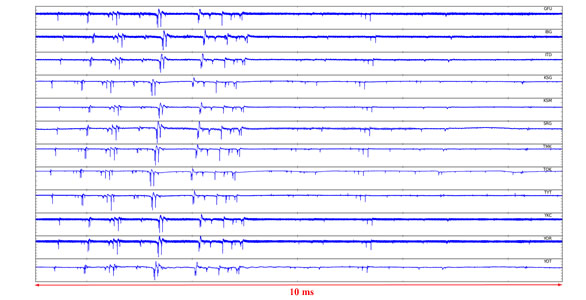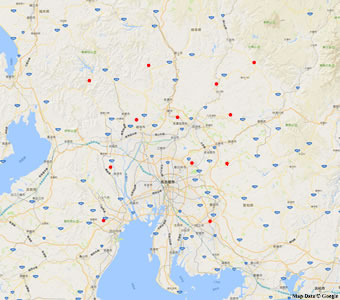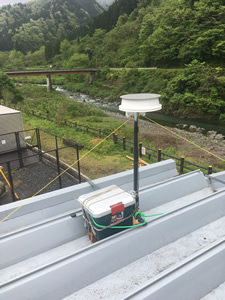
Research - FALMA
FALMA – Fast Antenna Lightning Mapping Array

FALMA is short for Fast Antenna Lightning Mapping Array. As the name suggests, this system uses an array of fast antennas to receive electromagnetic radiation from lightning discharges, and it can realize accurate lightning 3D mapping.
First observation has been made from June to September in 2017. Twelve sites were set up in Gifu and Aichi Prefecture of Japan. Distances between neighboring sites are from 20 to 30 km. Figure 1 shows locations of all sites. The network covers an area of about 90×90 km2.
Figure 2 shows a photo of a site. Each site has two basic parts: a fast antenna and a controlling box containing an AD converter, a PC and some other devices. The fast antenna is a flat plate antenna with a time constant of 200 μs and effective frequency band of about 500 Hz to 500 kHz. It is newly designed and manufactured by ourselves before the observation. It has much higher sensitivity than the old antennas. The high sensitivity enables it to capture pulses produced by relatively weak discharges, which ultimately enables more detailed 3D mapping.
The resolution of the AD converter is 16 bit. In order to achieve a timing accuracy as high as possible, the sampling rate is set to 25 MS/s, which equals to a timing accuracy of 40 ns, about the same as the GPS timing accuracy. A sampling rate of 25 MS/s implies a quite large amount of data flow. Normally during the time when a large amount of data is being written to the hard drive, new signals cannot be recorded, and the so-called “dead time” arises. We have developed a new data recording scheme to completely eliminate the dead time. This system can continuously record the full waveform data at 25 MS/s as long as there is space on the hard drive.
Figure 3 shows electric field change waveforms recorded by 12 sites. We can see the waveforms recorded at different sites have some time differences. The time differences are caused by different distances between the lightning discharge and each site. Based on the time differences, we can use the so-called “time-of-arrival” (TOA) method to make 3D locating. We can see there are many pulses in the waveform, and all of them can be located. There are actually many more small pulses that may not be discernible to the naked eye. We have developed an improved TOA method to locate as many as pulses, and with such location results, we can show the detailed development of lightning flashes in 3D.

The following video shows the development of an interesting lightning flash in 3D. This flash starts like a normal intracloud flash with a vertical channel connecting two charge layers. Some K changes can be seen propagating through the vertical channel. Suddenly, one leader developed downward from the lower layer and went directly to the ground. Later, the lower layer expanded slowly to the south. From the right panel, we can see many branches developing in the lower layer. Meanwhile, several dart leaders and K changes developed from the tips of leaders in the lower layer backward to the initiation point and into the downward channel. No more development from the upper layer can be seen. Shortly afterwards, one K change went slowly backward to the initiation point and suddenly created a new channel going downward. Instead of reaching the ground directly, it propagated horizontally for a short while and suddenly turned downward to the ground. It also created a new striking point.
Video 1
FALMA can not only show the detailed 3D structure of a single flash, due to the capability of continuous recording, it can also monitor all lightning activities in any thunderstorm passing over the network. Video 2 shows the lightning activities from 17:30 to 18:30 on August 22. This period has the most frequent lightning in the summer of 2017. In this video, we can see numerous lightning flashes occurred at several places. General structure of each flash can be recognized. The overall lightning activity gradually moved to the west, indicating the movement of the thunderstorm.
Video 2
More videos of lightning flashes imaged by FALMA
Realtime lightning monitoring by FALMA(中部・北陸地方リアルタイム雷放電状況)
Publications
- Wu, T., Wang, D., Huang, H., & Takagi, N. (2021). The Strongest Negative Lightning Strokes in Winter Thunderstorms in Japan. Geophysical Research Letters, 48, e2021GL095525, doi:10.1029/2021GL095525. link
- T. Wu, D. Wang, N. Takagi (2021). Compact Lightning Strokes in Winter Thunderstorms. Journal of Geophysical Research: Atmospheres, 126, e2021JD034932, doi:10.1029/2021JD034932. link
- T. Wu, D. Wang, N. Takagi (2020). Multiple‐stroke positive cloud‐to‐ground lightning observed by the FALMA in winter thunderstorms in Japan. Journal of Geophysical Research: Atmospheres, 125, doi:10.1029/2020JD033039. link
- Shi, D., Wang, D., Wu, T., & Takagi, N. (2020). A Comparison on the E‐change Pulses Occurring in the Bi‐level Polarity‐opposite Charge Regions of the Intra‐Cloud Lightning Flashes. Journal of Geophysical Research: Atmospheres, 125, doi:10.1029/2020JD032996. link
- T. Wu, D. Wang, N. Takagi (2020). Upward negative leaders in positive upward lightning in winter: propagation velocities, electric field change waveforms, and triggering mechanism. Journal of Geophysical Research: Atmospheres, 125, doi:10.1029/2020JD032851. link
- T. Wu, D. Wang, N. Takagi (2020). A negative cloud-to-ground lightning flash initiating at a high altitude and starting without classic preliminary breakdown pulses. Journal of Atmospheric Electricity, 39(1), 16-32, doi:10.1541/jae.39.16. link
- Shi, D., Wang, D., Wu, T., & Takagi, N. ( 2019). Temporal and Spatial Characteristics of Preliminary Breakdown Pulses in Intracloud Lightning Flashes. Journal of Geophysical Research: Atmospheres, 124, 12901– 12914. https://doi.org/10.1029/2019JD031130. link
- Gao, P., Wang, D., Shi, D.,Wu, T., & Takagi, N. (2019). Characterization of Multitermination CG Flashes Using a 3D Lightning Mapping System (FALMA). Atmospheres, 2019, 10(10), doi:10.3390/atmos10100625. link
- Wu, T., Wang, D., & Takagi, N. ( 2019). Velocities of positive leaders in intracloud and negative cloud‐to‐ground lightning flashes. Journal of Geophysical Research: Atmospheres, 124, 9983– 9995. https://doi.org/10.1029/2019JD030783. link
- Shi, D., Wang, D., Wu, T., & Takagi, N. (2019). Correlation Between the First Return Stroke of Negative CG Lightning and Its Preceding Discharge Processes, Journal of Geophysical Research: Atmospheres, 124, 8501– 8510, doi.org/10.1029/2019JD030593. link
- Ting Wu, Daohong Wang, Nobuyuki Takagi (2019), Intracloud lightning flashes initiated at high altitudes and dominated by downward positive leaders. Journal of Geophysical Research: Atmospheres, 124, 6982–6998, doi:10.1029/2018JD029907. link
- Wu, T., Wang, D., & Takagi, N. (2018). Locating preliminary breakdown pulses in positive cloud‐to‐ground lightning. Journal of Geophysical Research: Atmospheres, 123, 7989–7998.link
- Wu T., D. Wang, N. Takagi (2018), Lightning Mapping with an Array of Fast Antennas, Geophys. Res. Lett., 45, 3698-3705, doi:10.1002/2018GL077628.link
Acknowledgement/謝辞 本観測の実施にあたっては次の市町村、役所または施設、個人の方々から多大な協力・支援をいただきました。関係各位に厚く御礼を申し上げます。
- 揖斐川町水と森の学習館
- 関市板取事務所
- 加子母総合事務所
- 白川町加藤利春様(個人)
- 富加町渡辺貞司様(個人)
- 八百津町しおなみ山の直売所
- 養老町スマイルみずほ(株)
- 春日井市渡邊真一郎様(個人)
- 土岐市八勝園湯元館
- 四日市市アガタ製作所(株)
- 豊田市上郷コミュニティセンター
*Some old web browsers may not be able to play the videos.Contact Ting Wu (wu.ting.x4(at)f.gifu-u.ac.jp) for more information.

